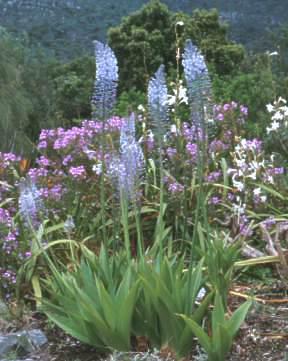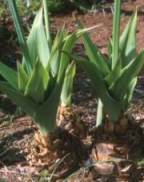Merwilla plumbea
Merwilla plumbea (Lindl.) Speta
Family: Hyacinthaceae
Common names: wild squill, blue squill, blue hyacinth, blouberglelie, blouslangkop, inguduza
Introduction
Merwilla plumbea is a graceful perennial bulb, and with its tall plumes of blue flowers, the showiest of the South African scillas.
Merwilla plumbea is the name given to a combination of several species, namely S. kraussii, S. natalensis and S. plumbea. The description below pertains primarily to the form previously known as Scilla natalensis.

Description
Description
It is a variable species, with individuals and populations of differing bulb size, flower colour, leaf coloration etc. In general it produces a large bulb, 10 to 15 cm in diameter, covered with firm, hardened, papery brown or purplish tunics (bulb scales). It is deciduous, growing during summer and dormant in the winter.

A rosette of 6 to 9 broad, tapering leaves emerges from the top of the bulb in spring. The leaves are attractive in their own right, with clearly distinct veins which give them a two-tone effect, particularly when back-lit. Their colour is light green with white-grey overtones, they can be entirely green, or they can have purplish colouring on the margins, at the base or at the apex of the leaf, or the underside can be partially or entirely shaded with purple. They can be completely hairless, or one or both sides can be covered in short hairs. The leaves of a well-grown plant can reach a height of 30 to 50 cm with about equal spread.

The inflorescence is a many-flowered slender raceme of bright violet-blue, or pale blue, or blue and white, star-shaped flowers each one carried on a delicate amethyst blue stalk, giving the overall effect of a misty blue plume floating in mid-air. There is also a white form, although we don't have specimens in the Garden as yet. The flower stalks are produced either just before or with the new leaves in spring to early summer (October), and are usually about 1 m tall, although some are as short as 0.75 m and a few can reach a height of about 1.4 m. The flowers have a honey-like scent towards evening and are visited by bees during the day. The seed, which is formed in capsules that split when mature, does not look much like seed. It is beige in colour, somewhat irregular in shape and a bit wrinkled, 6 mm long x 2-3mm wide tapering to a point. It is light in weight and dispersed by the wind. It does not last long unless it is refrigerated (not frozen) where it will last for a number of years.
Merwilla plumbea has shown itself to be selectively toxic to mammals. It is said to be poisonous to stock, particularly when the young leaves appear in spring. Experiments on sheep, using fresh bulb as a drench, proved fatal to the sheep, yet it has been proven an ineffective rat poison. It is apparently toxic to man when raw, even the sap is reported to burn the skin, and for any preparations taken internally the plant must first be heated. This plant should be treated with extreme caution, as taking any part of it internally is potentially fatal.
Conservation Status
Status
Its Red Data conservation status has recently been upgraded from Insufficiently Known to Vulnerable due to its being a very popular item in the KwaZulu-Natal muthi trade. Intensive harvesting is causing a decline in wild populations over an ever-increasing area of its distribution range.
Distribution and habitat
Distribution description
Merwilla plumbea occurs on the east of southern Africa, throughout the Eastern Cape, Lesotho, KwaZulu-Natal, Free State, Swaziland and into Mpumalanga where it is found growing in a variety of habitats from sunny slopes, rocky hills, cliffs and ledges, to damp cliff faces, near waterfalls, in moist depressions, on the edges of streams and vleis (wetlands) to coastal areas, in groups or as solitary specimens.
Derivation of name and historical aspects
History
This genus has been named after F van der Merwe, a botanist who worked on this family. The species name refers to the lead blue colour of the flowers.
Merwilla plumbea belongs in the family Hyacinthaceae (hyacinth family). It was previously called Scilla natalensis.
The Afrikaans name blouberglelie, which means blue mountain lily, is also applied to other South African species of Scilla and is a name that has been in use for hundreds of years. It earned the name blouslangkop, which means blue snake's head, presumably because the emerging flower stalk resembles a snake, and the tips of the flower stalks are often coloured bluish-purple. The Zulu name inguduza means "searching the body for the cause of the ailment", indicating its use in KwaZulu-Natal as a diagnostic tool.
Merwilla plumbea belongs in the family Hyacinthaceae (hyacinth family), formerly part of the Liliaceae (lily family), a family of perennial bulbous herbs consisting of ±46 genera and ±900 species found in Africa, Eurasia and North America but most richly represented in southern Africa and in the Mediterranean region to south west Asia. Other noteworthy southern African members of this family include Veltheimia bracteata, Lachenalia mathewsii, Eucomis species (pineapple lilies) and Ornithogalum species (chinkerinchees) while species more familiar to northern hemisphere gardeners include the hyacinth, Hyacinthus orientalis and the bluebell, Hyacinthoides non-scripta.
Uses
Use
Merwilla plumbea has shown itself to be selectively toxic to mammals. It is said to be poisonous to stock, particularly whenthe young leaves appear in spring. Experiments on sheep, using fresh bulb as a drench, proved fatal to the sheep, yet it has been proven an ineffective rat poison. It is apparently toxic to man when raw, even the sap is reported to burn the skin, and for any preparations taken internally the plant must first be heated. This plant should be treated with extreme caution, as taking any part of it internally is potentially fatal.
The bulb is used medicinally in South Africa and is one of the most popularly traded muthi (meaning traditional medicine and pronounced moo-tea) items in KwaZulu-Natal. Warmed fresh bulb scales, slightly burned bulb scales and decoctions of the bulb are used externally as ointments for wound-healing, to treat sprains, fractures, boils and sores and to draw abscesses. The ash from a burnt plant, and the bulb in powdered form, is rubbed into cuts and scratches, and over sprains and fractures. Decoctions are taken as enemas for female infertility and to enhance male potency and libido. It is also known to be used as a purgative, a laxative and for internal tumours, and is used in conjunction with other ingredients in infusions taken during pregnancy to facilitate delivery and in treatments for chest pain and kidney troubles. It is also an ingredient in a medicinal preparation for cattle suffering from lung sickness. It has magical properties for the Tswana who rub the powdered bulb into the back, joints and other body parts to increase their strength and resistance to witchcraft. The plant appears to have significant analgesic and antimicrobial activity, and phytochemical studies have found that it contains compounds known to possess anti-inflammatory and anti-mutagenic properties which would support its use for the treatment of strains, sprains and cancers. Although its effect on sheep appears similar to that caused by cardiac glycoside poisoning, whether or not it contains the same heart glycosides found in the closely related genera of Drimia and Urginea remains to be determined.
Growing Merwilla plumbea
Grow
They are relatively drought tolerant, but to grow well they require ample water in summer. As the leaves start to yellow in late summer to autumn, water can be withheld. It is best to keep them dry during winter, but they are undamaged by the wet Cape Town winters provided the soil is well-drained or they are growing on sloping ground. Merwilla plumbea can be considered frost hardy to zone 9 (-7 °C / 20 °F) but in severely cold climates it is probably best grown in containers which can be taken indoors during winter, or grown in a glasshouse.
Propagation is by seed or division of offsets. Seed germinates readily, but it must be noted that it does not last long unless it is refrigerated. It can be sown immediately after harvest in summer, or the previous season's refrigerated seed can be sown in spring or summer. Germination occurs within 7 days and the plants should flower in their third or fourth year. Again it is recommended that the young plants be disturbed as little as possible in order to get them to flower as soon as possible, so sow the seed thinly in deep (minimum 10cm) trays or pots, or transplant them into larger individual pots/bags after thinning the seed trays, or during their second season.
Offsets (daughter bulbs) are produced at the base of a mature bulb and can be removed and replanted during the dormant period. If left undisturbed a single plant will in time become a clump of plants which can be lifted and divided during the dormant period, or the outer ones can be detached without lifting the entire clump. When dividing two bulbs it may be necessary to cut them apart. Dust the cut surface with a fungicide and store for at least 2-3 weeks in a cool dry spot to allow a seal to form over the wound. The divided bulbs can then be planted as described earlier.
References
- Douwes, E., Crouch, N.R., Symmonds, R., 2001, Blue Squill in the Red: Scilla natalensis as a Conservation Charge, PlantLife, 24 (14-19).
- Du Plessis, N., & Duncan, G., 1989, Bulbous Plants of Southern Africa, A guide to their Cultivation and Propagation, Tafelberg, Cape Town.
- Jackson, W.P.U., 1990, Origins and Meanings of Names of South African Plant Genera, U.C.T. Printing Dept., Cape Town.
- Jeppe, B., 1975, Natal Wild Flowers, Purnell, Cape Town
- Leistner, O.A. (ed.), 2000, Seed plants of southern Africa: families and genera, Strelitzia 10., National Botanical Institute, Pretoria.
- Smith, C.A., 1966, Common Names of South African Plants, Dept. of Agricultural, Botanical Survey Memoir No 35, Government Printer.
- van Wyk, B.E., van Oudtshoorn, B., Gericke, N., 1997, Medicinal Plants of South Africa, Briza Publications, Pretoria, South Africa.
- Germishuizen G and MeyerN.L.(eds) 2003. Plants of Southern Africa. Strelitzia 14. NBI.Pretoria
Credits
Alice Notten
Kirstenbosch NBG
October 2001
Plant Attributes:
Plant Type: Bulb, Perennial
SA Distribution: Eastern Cape, Free State, KwaZulu-Natal, Mpumalanga
Soil type: Sandy
Flowering season: Spring, Early Summer
PH:
Flower colour: Blue, White
Aspect: Full Sun, Morning Sun (Semi Shade), Afternoon Sun (Semi Shade)
Gardening skill: Easy
Special Features:
Horticultural zones











Rate this article
Article well written and informative
Rate this plant
Is this an interesting plant?
User Comments
Jackie Strydom, South Africa
October 29, 2018 at 2:20 PMFascinating article. I found this plant in my garden when I moved in to my house in late Autumn, but didn't think anything much about it.That is until about two weeks ago when the flowering started and this most amazing plant exploded into bloom with these beautiful deep blue and white, star like flowers. I am so pleased I identified it. I have four in my garden and only one of the others is flowering and is lighter in colour, but still beautiful. The other two are still probably a little young and I will look forward to seeing them bloom in the next few years. Thanks for the information.
Login to add your Comment
Back to topNot registered yet? Click here to register.